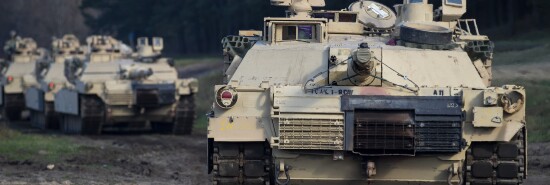
Failing to provide tanks to Ukraine, Biden administration repeats deceptive excuse
Tom Rogan
Video Embed
The Biden administration deserves credit for consolidating U.S. allies in Ukraine’s support. Still, whenever the administration is asked why it won’t provide a particular weapons system to Ukraine, it tends to offer a disingenuous excuse. Rather than admitting its fear of overly agitating Russia, the administration claims that the Ukrainians don’t need the system in question or would be unable to operate it effectively.
National security adviser Jake Sullivan encapsulated this approach last April. Explaining why the U.S. wasn’t sending certain weapons to Kyiv, he said it was because Ukraine “doesn’t have a version that could effectively be integrated into the fight. Sorts of systems like this include longer-range anti-aircraft systems, artillery systems, and coastal defense systems.” As I noted at the time and as the subsequent, highly effective deployment of these weapons to Ukraine has proven, Sullivan’s excuse never added up.
The White House is now repeating this false mantra in explaining why it won’t send M1A2 Abrams tanks to Ukraine. Senior Pentagon official Colin Kahl observed that, “The Abrams tank is a very complicated piece of equipment. It’s expensive, it’s hard to train on. It has a jet engine, I think it’s about three gallons to the mile of jet fuel. It is not the easiest system to maintain.”
‘WHERE’S THE OTHER FOUR?’ OR WHY WE NEED A DEFENSE INDUSTRY REVOLUTION
This matters for two reasons.
First, tanks would allow Ukraine to provide a highly effective penetration force to defend or recapture territory and isolate, then destroy Russian forces. Second, Germany says it won’t provide its own Leopard 2 tanks to Ukraine, nor allow allies that own those tanks to do so, unless the U.S. also provides tanks to Ukraine. Reflecting its higher risk tolerance in this conflict, only Britain has thus far pledged to provide tanks (12 of its Challenger 2s) to Ukraine.
Still, in this admittedly rare case, Berlin’s concern is legitimate: it fears being a unilateral target for Russian escalation. Considering escalating Russian nuclear threats and strategic posturing, and the particular sensitivity of these concerns in Germany, it is astonishing that the Biden administration does not understand Berlin’s concern here. Moreover, it should be leaping to guard against the attenuated risk of inviting Russia to divide the NATO alliance.
But back to the central point, as with Jake Sullivan’s April 2022 spin, Kahl’s excuses simply do not add up.
First, the power of the Abrams engine is an advantage, not a weakness. It allows for the same basic benefit of the HIMARS artillery system that Ukraine has used so effectively. Namely that the Abrams engine power allows it to move very quickly where it is needed, then employed to deadly effect, and then relocated before it can be counter-targeted. Yes, it’s true that the Abrams requires a longer training cycle than the Leopard 2 and Challenger 2. Experts estimate that it would take 4-6 weeks to train a Ukrainian crew to operate the Challenger 2. A similar schedule would apply to the Leopard 2. Training for the M1A2 Abrams takes 22 weeks, but this could likely be shaved to 12 weeks with acceptable risk.
Again, however, what Germany wants here is not a division worth of Abrams for Ukraine, but rather a symbolic U.S. commitment. Geography, its multinational operator base, and the shorter training cycle all mean that the Leopard is better suited to Ukraine’s needs than the Abrams. There is also an advanced NATO armor training center in Western Poland which would allow Ukrainian forces to train just across the border. Germany just wants the U.S. to publicly and physically have its back. Were the U.S. to commit even a few Abrams tanks (less than 10 would likely suffice) to Ukraine, it would establish a tripwire deterrence against Russia’s singling out of Germany. Considering the capacity of the Russian intelligence services for theatrical but vicious aggression, Germany has reason to fear more than direct Russian military retaliation.
The top line is clear. Or at least it should be. The U.S. should pledge a small but symbolic commitment of Abrams tanks to Ukraine. It should then pressure Germany and other European allies to follow that commitment with their own greater armored provisions.
CLICK HERE TO READ MORE FROM THE WASHINGTON EXAMINER
